"Show your true colours"
9 August 2019
How the clever use of colour can have psychological benefits in the work place
We can sometimes forget just quite how much colour affects our mood and daily life.
We constantly associate colours with feelings, whether that’s yellow for happiness or red for anger. The colours we surround ourselves with can affect how we feel so it only makes sense that being aware of the nuances of colour psychology and incorporating them in to your work place design can help achieve the right kind of atmosphere and consequently, level of productivity in your office.
Carl Jung,
a pioneer in the psychology of colour developed the basic theory that different colours have specific meanings. They are both learned socially and are a product of biological instinct. Colour is subconsciously processed and our behaviour is affected by it.
This is not to say that it’s exactly the same for everyone. Different colours mean different things to different people; we will all associate distinct experiences with varying colours whether that’s of cultural or of personal influence. But still, we can confidently say that certain tones are generally associated with specific moods.
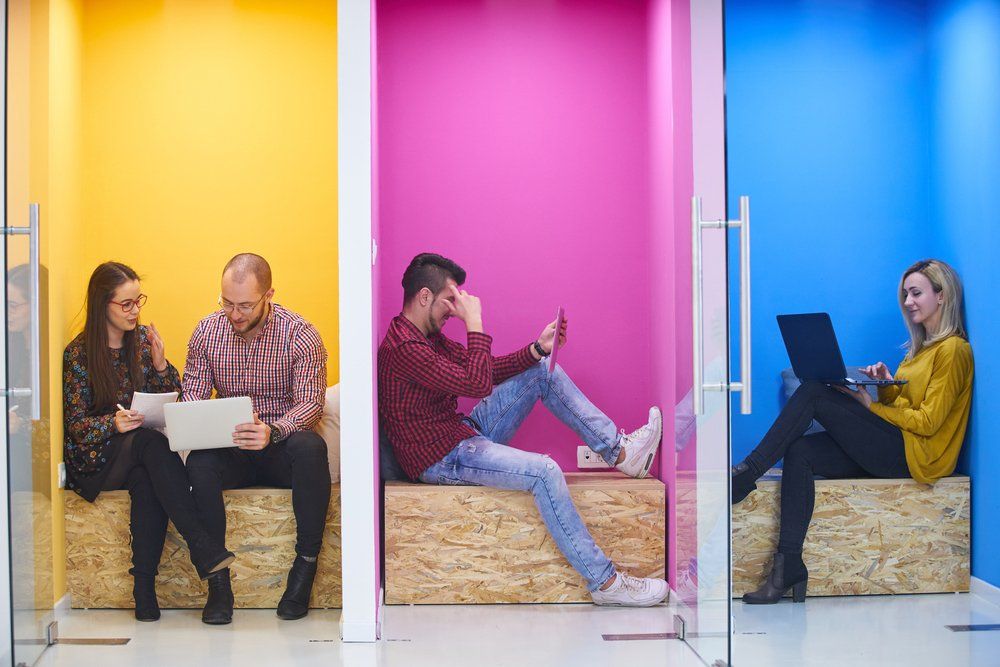
Colours with warmer
undertones like yellow, red and orange foster feelings of both warmth
and comfort
but also passion
and anger,
they can be useful for injecting energy
into a work environment. Cooler
tones such as blue, green and purple are meant to encourage calmer more relaxed emotions, good for decision making
and stability,
but can also give a feeling of sadness.
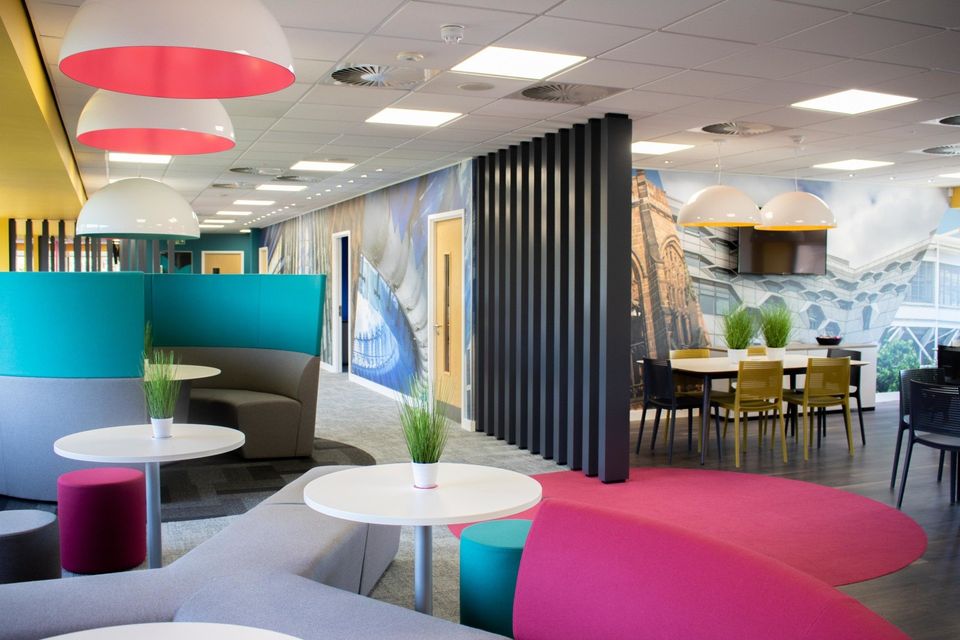
So as you can imagine this is an important thing to consider when designing your office space and its worth considering what kind of atmosphere you want to create, whether that be energetic, fast paced and full of vigour, or if it’s more a serious steady and calm environment.
Green
ever associated with nature and the outdoors, green helps reduce anxiety and minimises stress on the eyes, especially if you’ve been staring at a screen all day. Inspiring a harmonious working environment, the shade can be great throughout an office space but works particularly well in break out spaces or well-being rooms because the colour gives a feeling of rejuvenation. Varying shades and tones of green can add depth and psychologically replicate an organic outdoor environment. This can be useful in spaces where the outside meets the in (garden rooms for example) because it brings the two together. A green colour pallet doesn’t just have to be limited to environmentally focused businesses, its soothing quality can work well in any business, particularly those which require a calming influence, this can work well in meeting rooms or waiting areas.
Blue
reminds us of the sky and the sea, both of which foster a feeling of calmness. Scientifically it has been proven to lower the heart rate and promote concentration. Blue is seen as the colour of intellect and can be especially useful in conference rooms where brainstorming is encouraged. Getting the right tone is important, softer blues can help you focus which is a plus if your employees have to maintain concentration for extended periods of productivity. However, avoid darker blue tones because they have been said to bring out feeling of gloominess, despite this they can work well for feature walls and as colour accents. In terms of brand identity, blue is associated with reliability and trustworthiness, this can be really useful for law firms and businesses in the financial or medical sector.
Sunny Yellow
can brighten up your office and inject fun, warmth and optimism. It is also proven to aid digestion, this can be really beneficial in canteen or break out spaces. Yellow also works particularly well in creative industries with bustling, lively offices because its vibrancy stimulates the imagination. Yellow works best in a splash, you don’t want to be too heavy handed with it, because bright tones or too much can strain the eyes and an excess of it tips that creative buzz over the edge and you’re left with a feeling of anxiety. It is possible to strike the right balance with a few yellow accents or feature walls, perfect for bringing positivity and dynamism into your work space without being overwhelming.
Orange
similarly oranges can add zest and energy into a space, used sparingly and in bright tones it can relieve sadness and bolster your confidence, too much and it feels oppressive and sluggish. Oranges work best in social care sectors.
Brown
wooden floors and furniture can ground an office space. When paired with greens or blues it can help bring the outdoors in. Brown tones generally go unnoticed but they can subtly give the warm impression of sturdiness, reliability and age. This translates into a feeling of trust, perfect for waiting areas for your clients and conference rooms. To be avoided however are creams and magnolia shades that can make an office feel dated.
Red
is dramatic, it grabs your attention encouraging feelings of passion and danger. Research has found that the colour red raises your heart rate, blood pressure and actually makes you hungry. (This is why you see it so much in fast food restaurants – often with yellow!) But aside from the increased appetite, the physical effect on the body can help stimulate creativity in a high energy office environment. Avoid red in meeting rooms or the main body of your office space because it can foster confrontation and frustration (and you might see your staff wondering off to the kitchen more than you’d like!) but it can be beneficial in places where you don’t want your staff to dawdle, like corridors or break out spaces. Either way it’s a bold statement and certainly makes an impact.
Be cautions of Pinks.
Striking tones like magenta can make a real impact and show that your business is vibrant and energetic. They can work well on feature walls or decorative accents but softer tones like blush or baby pink can seem unprofessional, we associate those colours with comfort and warmth and not necessarily professionalism.
Black
finishes can make your office feel slick and sophisticated, we associate it with authority and reliability, however its vital to get the balance right because too much can feel oppressive and can make your space feel smaller. When contrasted with white and softened with grey hues the image of your business is one of authority and professionalism. This can be especially effective in reception and waiting areas, where first impressions really count. A monochromatic base pallet can also allow accent colours such as pops of yellow or magenta to really stand out. If your branding and marketing is vibrant and colourful a neutral black and white base pallet with injections of appropriate colours can tie in your brand identity with your office decor without going over the top.
White
conveys professionalism and minimalism, it can open up a space and make it feel bigger. We psychologically connect it with cleanliness and sterility, this can be an advantage if your practice is medical or pharmaceutical and you want to use it in front of house waiting areas or consulting rooms, but be careful as it can verge on the unfriendly and isn’t a very inspiring or energising colour to have in general office space. Despite this it’s a reliable base colour that will allow other focal points to shine.
Don’t underestimate a Grey
pallet. We often associate greys with sadness or dullness but used as a base or backdrop it gives a very modern feel to an office space (it’s the new magnolia!). A neutral grey base, varying in shades can add depth whilst allowing other accent colours to come to the fore.
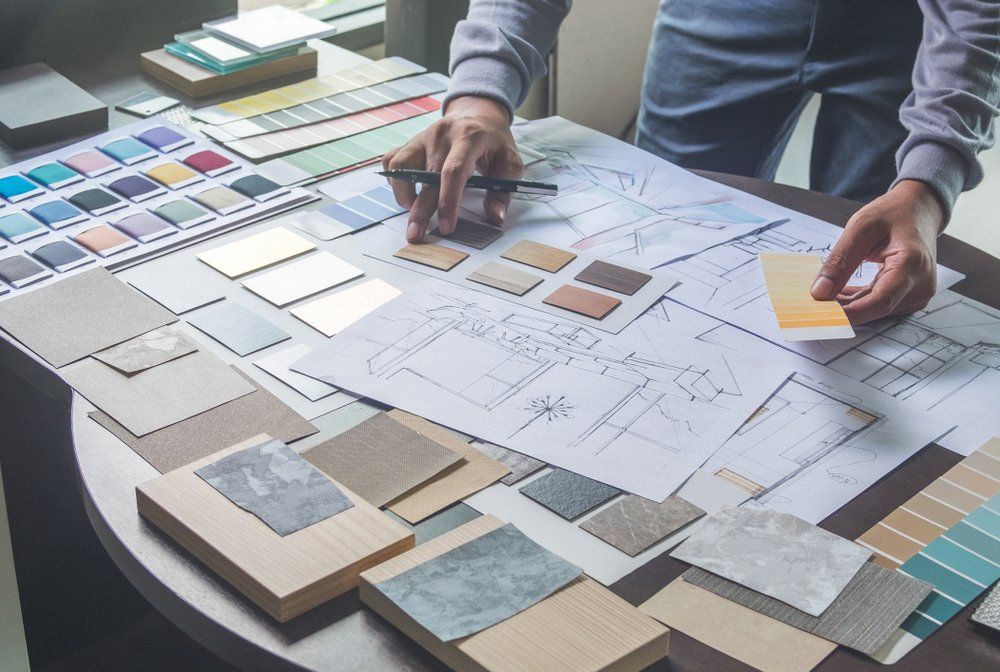
Picking the right colour scheme that works for both your staff and your clients is so important. We at Hi Design always take into consideration the atmosphere and working environment of your office space, the colour pallet of your marketing and brand identity and the goals you want to achieve when consulting on interior office space design and colouring.
Hi Design ‘work spaces that work’
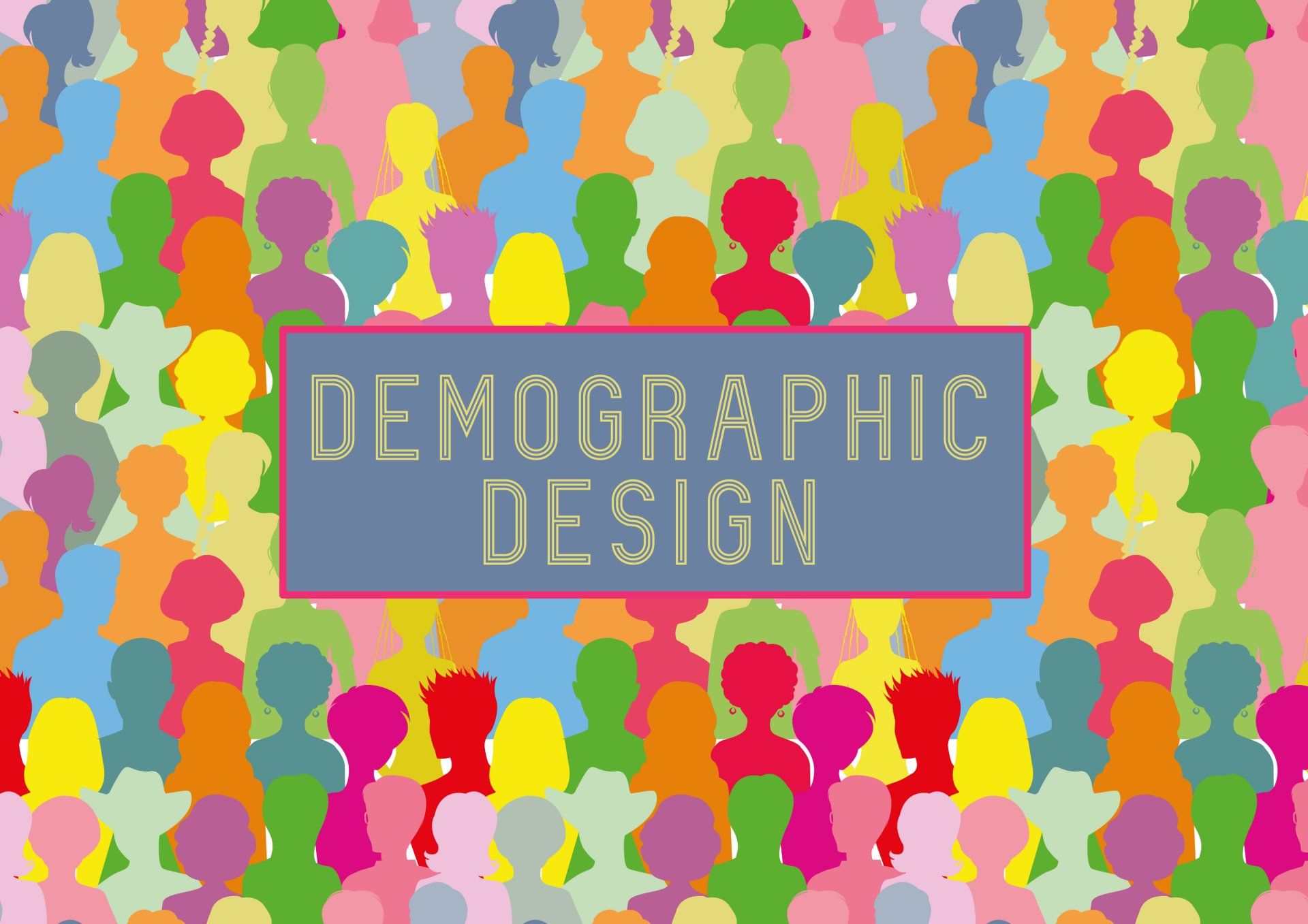
As our population grows older and our social and technological landscape changes we are increasingly seeing the emergence of different and distinct generations, from the Silent Generation to Generation Z. This means that a diverse group of people coming from different cultural backgrounds and influences will be operating in the work force at the same time. From an office design perspective, this means that you might find yourself faced with opposing demands. When considering an office re-design it’s important to look at your staff demographics to get a feel for what will work best in your workspace to achieve maximum productivity and make everyone feel comfortable. So what defines each generation? The Silent Generation, typically born between 1925 and 1942, sometimes called the lucky few, despite being born in the wake of the great depression and Wold War II this generation enjoyed relative prosperity growing up in the 50s and 60s. Although the majority of this generation are now retired, it’s not uncommon to still find them in the work place. Baby Boomers. This generation, born between 1946 and 1964 were until recently the largest generation worldwide, making up 14.8 mil of the UK’s population. In the office, this cohort usually values quite spaces and privacy. Generation X. This group were typically born between the mid 1960s and the early 1980s. Sometimes dubbed disaffected this Gen saw a rapid change in societal values and more maternal participation in the workplace, the predecessor of millennials, they became increasingly independent showing great entrepreneurial savviness. Millennials, the most talked about generation, generally accepted as being born from 1981 to 1996 are up to speed with technology and social media, are goal oriented and desire a flexible work life balance. In the office they generally prefer open plan design and value collaborative spaces. Gen Z, these are your university grads, apprentices or interns. Born from the mid 90s to the mid 2000s they will be the youngest people you might employ. Never having known a world without the Internet, like millennials they are incredibly tech savvy. Tolerant and accepting this generation is open and fluid with a keen interest in environmental issues. Like Millennials they will look for inclusive, environmentally conscious work places.
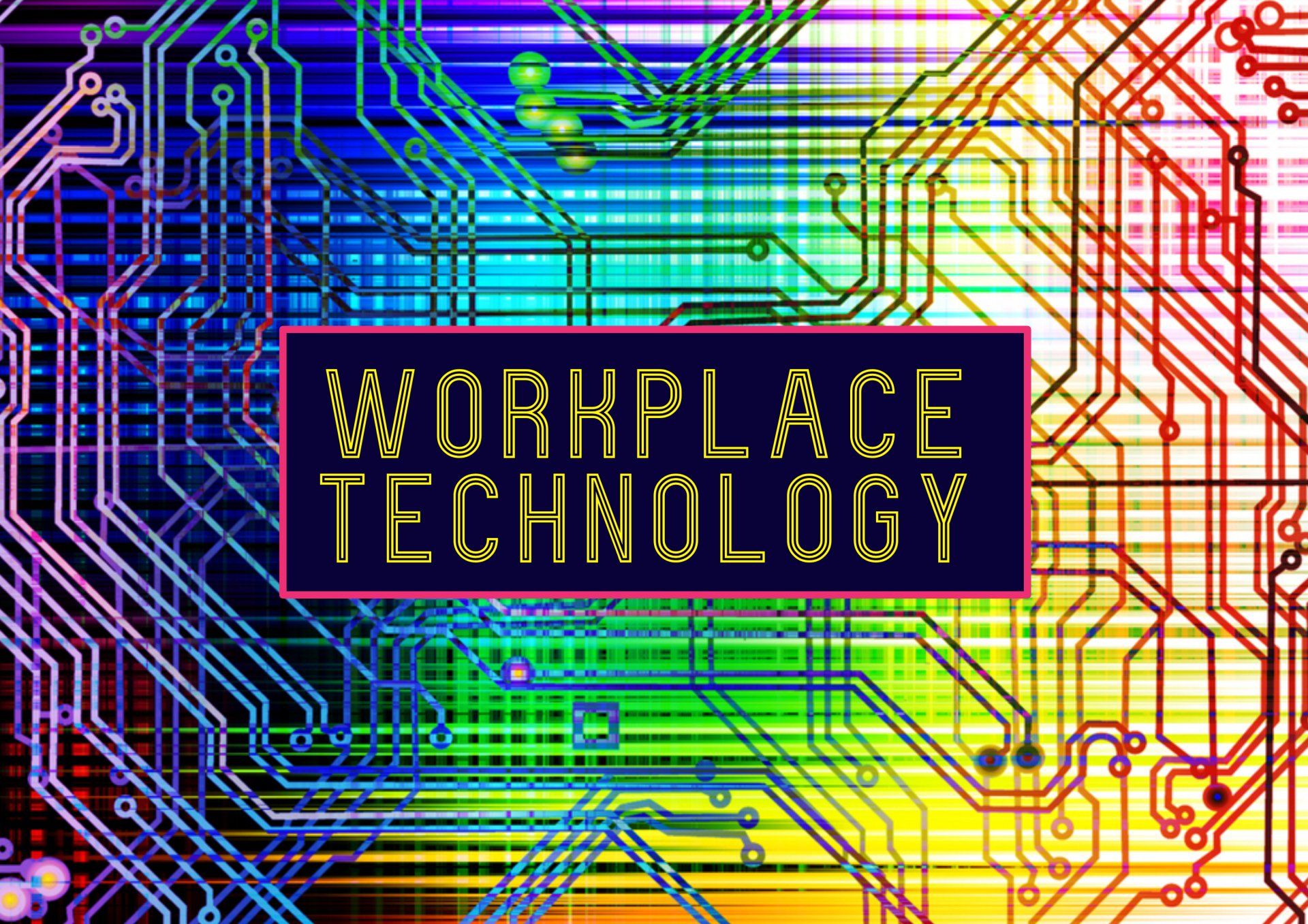
In previous articles we have discussed how companies are striving to improve their employee’s workplace experience through workplace design trends such as Agile working, Biophilia and Sensory Design. While these can improve productivity, creativity and staff retention, if the correct tools and technology are not in place, an employee’s ability to reach their full potential is significantly limited. Take, Agile Working for instance, (empowering staff to work where, when, and how they choose), without incorporating the correct tools and technology into the different area’s during the design process, i.e. quite zones, huddle areas, creativity spaces etc, they become simply areas with names, not interactive and productive spaces. To truly work, technology and workplace design need to be integrated from the very beginning. HARDWARE: The development of laptops , tablets and notebooks has enabled a more flexible way of working. It means you no longer need to be stuck at the same desk with a PC all day. (although a lot of companies are yet to break away from this nineties trend) Those that have fully embraced and invested in the latest mobile technology, have found that it’s had a positive impact on not only productivity, but also staff wellness. Employees feel motivated by this newfound freedom, allowing them to work from anywhere and at any time, be it at home or in the office. When Mobile technology is paired with an ‘Agile Work’ environment, one that allows employees to work in the area best suited to the task at hand, i.e. a quiet room for concentration, a huddle area for meetings and collaborations, this feeling of freedom extends further and you will also see improved staff retention, increased creativity and production. The ability to create a fully functional, interactive, and flexible work space is not just limited to laptops and mobile devices. INTERACTIVE WHITE BOARDS are helping people learn by increasing engagement and collaboration. A study by Microsoft finds that after 3 days most people can only retain 10-20 percent of written or spoken information. However, 65% of visual information is retained. No doubt if you have children, you will already know that they are using them in the classrooms. They are also a great investment for the workplace. Interactive whiteboards in a conference room setting enable you to combine digital content to create multi sensory experiences that make presentations stand out to clients and employees. Modern technology means that it now possible to transform any flat surface into an interactive interface for learning and collaboration. Used in huddle and creative zones, team members can visually share information, understand difficult concepts, work through problems, and develop their own ideas and solutions. Think ‘Avengers’ movies! Where you collaborate around a table, swipe, tap, flip and zoom in on projects, rather than just talking about them. DIGITAL DISPLAY SCREENS and easy to update digital media can be used to zone and create different environments within spaces or to convey information. For example: ESI Design created an 8-story digital installation for the Wells Fargo Centre in Denver, featuring floor-to-ceiling waterfalls, a grove of trees that sways in the breeze, sunrises and sunsets that appear at the right time of day, and a flock of nearly 4,000 birds that are animated in real-time using an algorithm that prevents flight patterns from repeating. This is a perfect example of merging Biophilia Design ( humans’ innate tendency to seek connections with nature is rooted in our biology) with modern day technology to create an immersive experience.

We all know that having a few pictures here and there in your work space can liven up the walls, but did you know that artwork in the office can up your productivity? Investing in art doesn’t have to be a daunting or expensive process and the benefits can have a hugely positive impact on your business. Studies conducted by Exeter university found that people working in what they called ‘enriched’ spaces (that’s to say offices decorated with colour, art, plants etc) were 17% more productive than those working in the more sterile, functional ‘lean’ spaces that the study tested against, and it’s pretty obvious that an aesthetically pleasing and welcoming work space leads to happier employees, this makes for a more engaged work force as well. But the benefits to having art in your office reach a lot deeper.
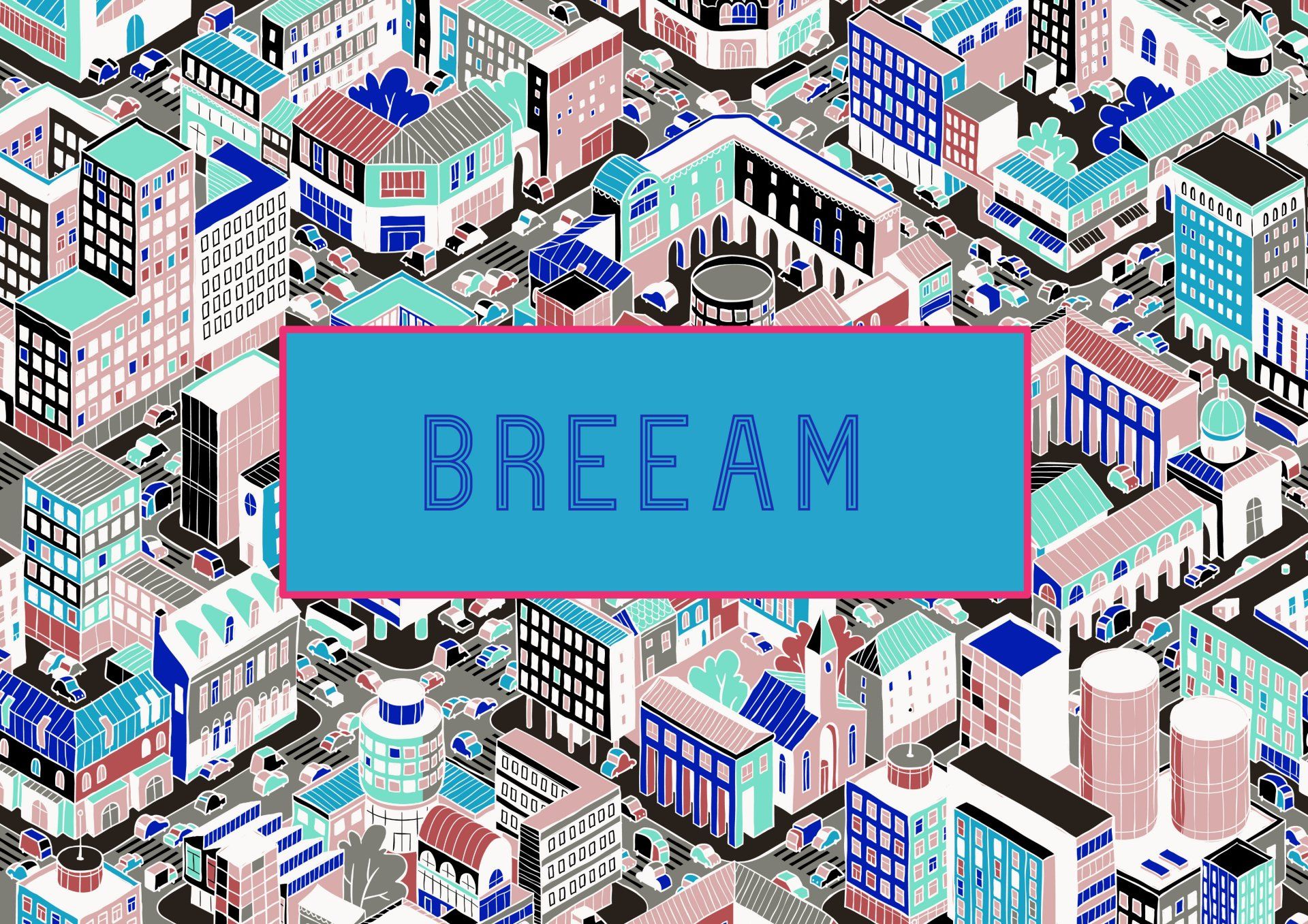
We are often asked by clients about how they can achieve a BREEAM Outstanding office building. Many don’t really understand what it is or how to go about getting an accreditation, so in today’s article we shed some light on this ‘fishy’ subject! Firstly, we should clarify that it does not actually have anything to do with fish. BREEAM (Building Research Establishment Environmental Assessment Method), first published by the Building Research Establishment (BRE) in 1990, is the world's longest established method of assessing, rating, and certifying the sustainability of buildings BREEAM rated developments are sustainable environments that enhance the well-being of the people who live and work in them, help protect natural resources and make for more attractive property investments. Accreditation's are not just for new buildings, but also include refurbishments and interior fit outs too. Sustainability is one of the key environmental issues of 21st century life and any business that wishes to be taken seriously in its commitment towards environmental responsibility should consider getting a BREEAM rating. Company’s leading the way in this arena include COCO COLA, IKEA & BLOOMSBERG. There are 10 categories in which you can score, but we thought we would look at the ‘HEALTH & WELLNESS’ category as it links in with previous articles on topics such as ‘CLEAN AIR’ ‘BIOPHILIA’ and AGILE WORKING’. This category encourages the increased comfort, health and safety of building occupants, visitors and others within the vicinity.
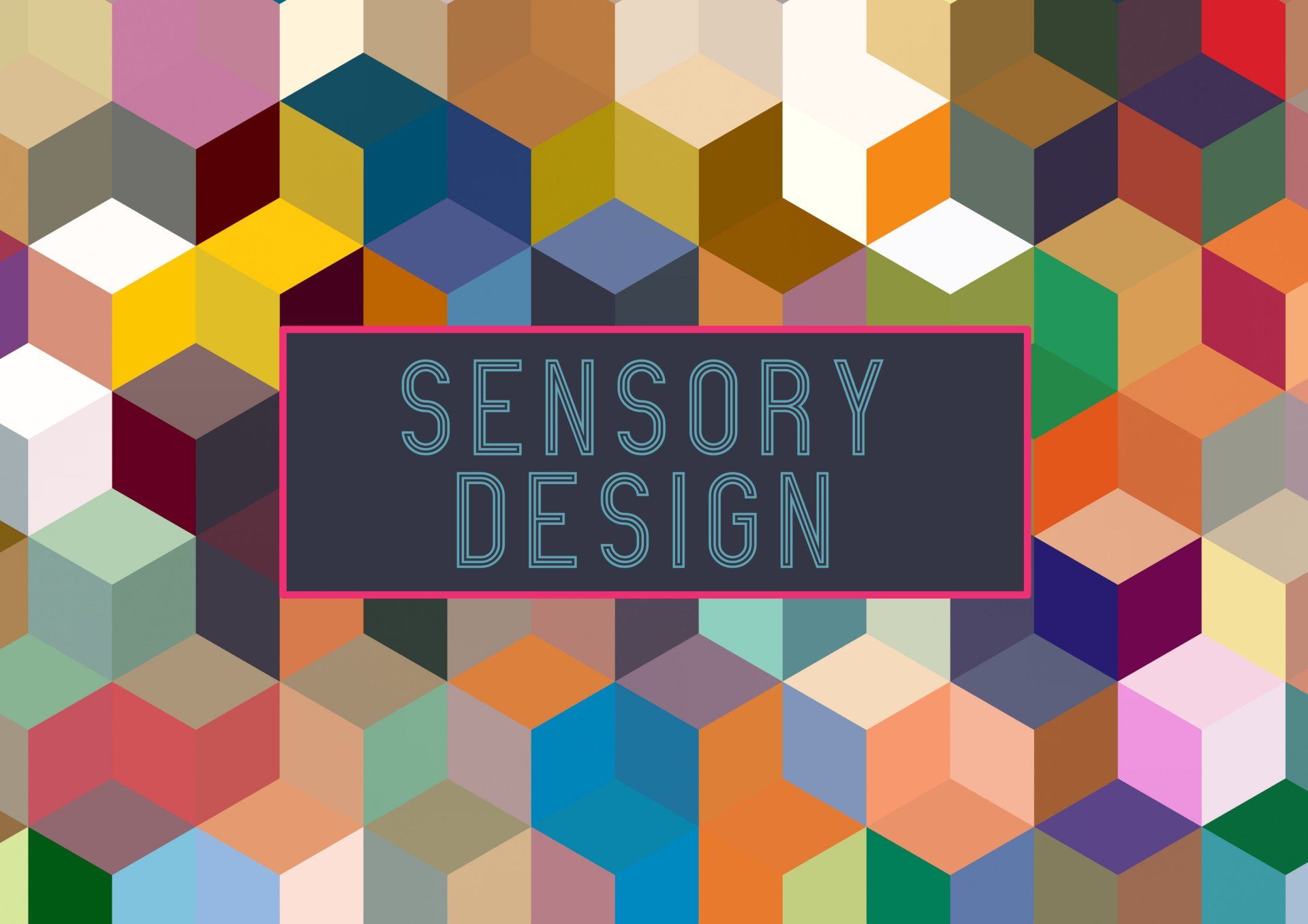
Good design looks great, yes – but why shouldn’t it also feel great, smell great and sound great? We’ve all heard how the smell of freshly brewed coffee can help sell a house, how spas use lavender to relax you, or how supermarkets lure us in with the smell of freshly baked bread. Until now, many office designers have focused on functionality or making things look pretty and ignored the other senses. Things are changing, as forward-thinking organisations are waking up to the benefits of Sensory Design. So, what do we mean by Sensory Design? Well put simply it involves incorporating sight, sound, touch, taste and smell into the workplace environment. The best designs incorporate all or most of the five senses. Let’s look at each one individually and the ways in which we can appeal to that sense through workplace design. Upon walking into a work space, SIGHT is undoubtedly the first of our senses to react to our surroundings. Sight takes in everything from colours, shapes, patterns, lighting and the actual size of a space. All these elements can be used to evoke feelings and to influence different outcomes, depending on what the end goal is. For example, Colours have been scientifically proven to have a physiological influence on us and colour Psychology is a popular design tool for promoting desired behaviours. Bright colours such as orange, yellow & lime green are stimulating (and yes there is a connection with citrus fruits), these colours used in common rooms or breakout spaces can aid interaction, lively discussions with colleagues and decision making. Whereas if you want to provide a quiet place where employees can concentrate on a project or take time out, the colours blue and purple are associated with calm, promoting mental clarity, and creative thinking. Using these colours in quiet spaces and wellness rooms can help create a sense of tranquility. Access to natural light also has a profound effect on employee’s well being and productivity at work. Artificial light that is too bright can cause headaches, where as lighting that is too dim can cause lack of focus and drowsiness. A recent study by an American university found that there is “a strong relationship between workplace daylight exposure and office workers’ sleep, activity and quality of life.” Where possible, it is essential to allow natural light to flow into a room. This is obviously easier to achieve in the early planning stages of a building, however it is still possible in existing buildings too, by using glass or Perspex partitions and mirrors in areas where windows are, thus helping the natural light reach further.

The week 23-29 September 2019 is 'Recycle Awareness Week' and sees two recycling awareness events. ‘Recycle Awareness Week’ and ‘Recycle Now Week’ So, let’s take a look at recycling in the workplace. Most of us now recycle at home, but do you recycle at work? Workplaces are notoriously full of paper, disposable coffee cups, cardboard, printer cartridges and more. All this stuff is recyclable, so it should be disposed of in the correct fashion. However, getting employees to recycle, understand where to dispose of their waste, and to know what items can be recycled can be a challenge. Though it may seem like a chore, recycling is essential to help protect the environment. Not only are you reducing the amount of waste that goes into landfill, you can also save your company money by spending less on waste disposal. It’s important that you do your part in the workplace to help encourage recycling. Some Interesting Facts 1 recycled tin can save enough energy to power a television for 3 hours. 1 recycled glass bottle can save enough energy to power a computer for 25 minutes. 1 recycled plastic bottle can save enough energy to power a 60-watt light bulb for 3 hours. 70% less energy is required to recycle paper compared with making it from raw materials. How do I encourage staff to use the recycling service? Here are some of our top tips. Encourage senior management to get involved and lead by example: their buy-in is important. It is also beneficial for key message come from them. Educate staff. Tell them why you are starting to recycle (why it will save money and what the environmental benefits will be). There is still a lot of confusion about what can be recycled, especially over plastics, so clearly labelled bins will make it easy to remind people to recycle. Install printers, which need a personalised code to collect printing. This should reduce the amount of redundant paper sitting on machines waiting for collection (some of which ultimately gets put in a bin at the end of the day!) Did you know that 40% of office waste comes from paper? Speak to cleaning staff to ensure that they recycle correctly. It’s great to separate materials in the office, but pointless if they all end up in the same big bin outside!
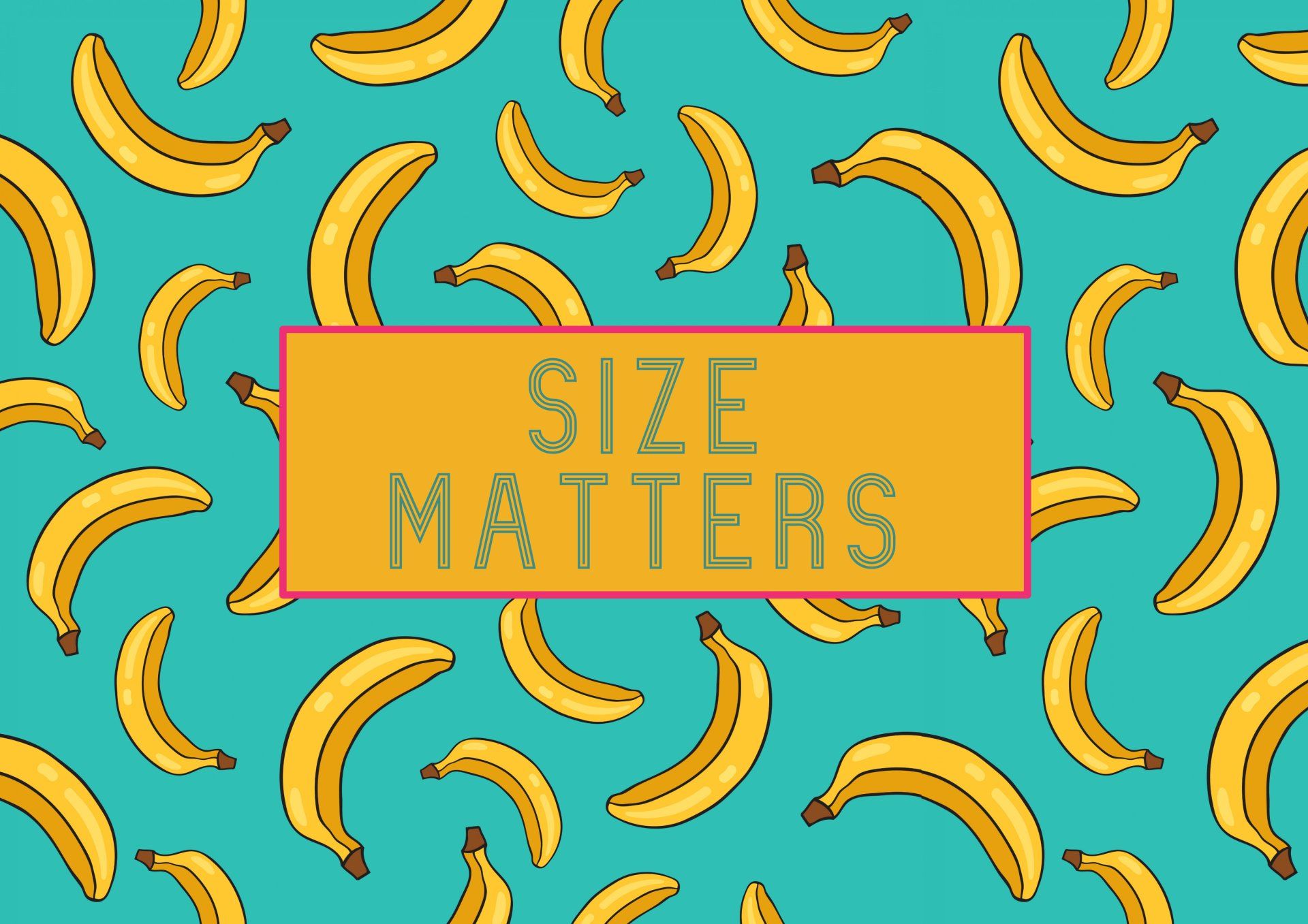
Office space is one of the biggest costs for a business, so over or under-estimating the amount of space needed can end up becoming an expensive exercise. Leasing too much space puts you at risk of paying for areas which are underutilised. Money spent on rent, utility bills, rates, service charges and fit-out could be better spent on increasing sales or even better, a healthier bottom line! Many companies occupy larger spaces than they need with the view that they can ‘fill out’ the gaps with desks as they expand. This is a great idea in principle; however having too much empty space doesn’t necessarily create the right impression of a successful thriving business. Empty spaces or desks can have a negative impact on employee motivation; the atmosphere can feel flat and lacking in energy. Furthermore, if staff are spread around, they can feel isolated from their colleagues, lonely and not part of the wider business. A recent survey by Relate revealed that 42 per cent of us don’t have a single friend at the office - pretty sobering, considering that British people work some of the longest hours in Europe. Similarly, renting too little space brings its own challenges. It can limit business growth and hinder staff expansion. Building services such as the air-conditioning (which is sized to the building–control approved headcount) can struggle to cope with the increasing number of bodies. Air feels stale and fluctuations in temperature across the building can irritate staff. Queues for toilets or to use a break-out space add to stress levels. Mental Well-being can suffer, personal space is important to productivity and happiness. Not only that, but being packed in can breed tensions in the office. When one worker is trying to get a project done and he or she is sitting near others who are chatting away, resentment is just around the corner. So, what can you do to determine how much office space you need? The way in which companies use space varies considerably from company to company and industry to industry, so why are so many organisations hung up on ‘how much space do I need per employee?’ Should we really be asking: What tasks do our staff complete in a day? Where is the best place to complete these tasks? And What culture do we want to create?
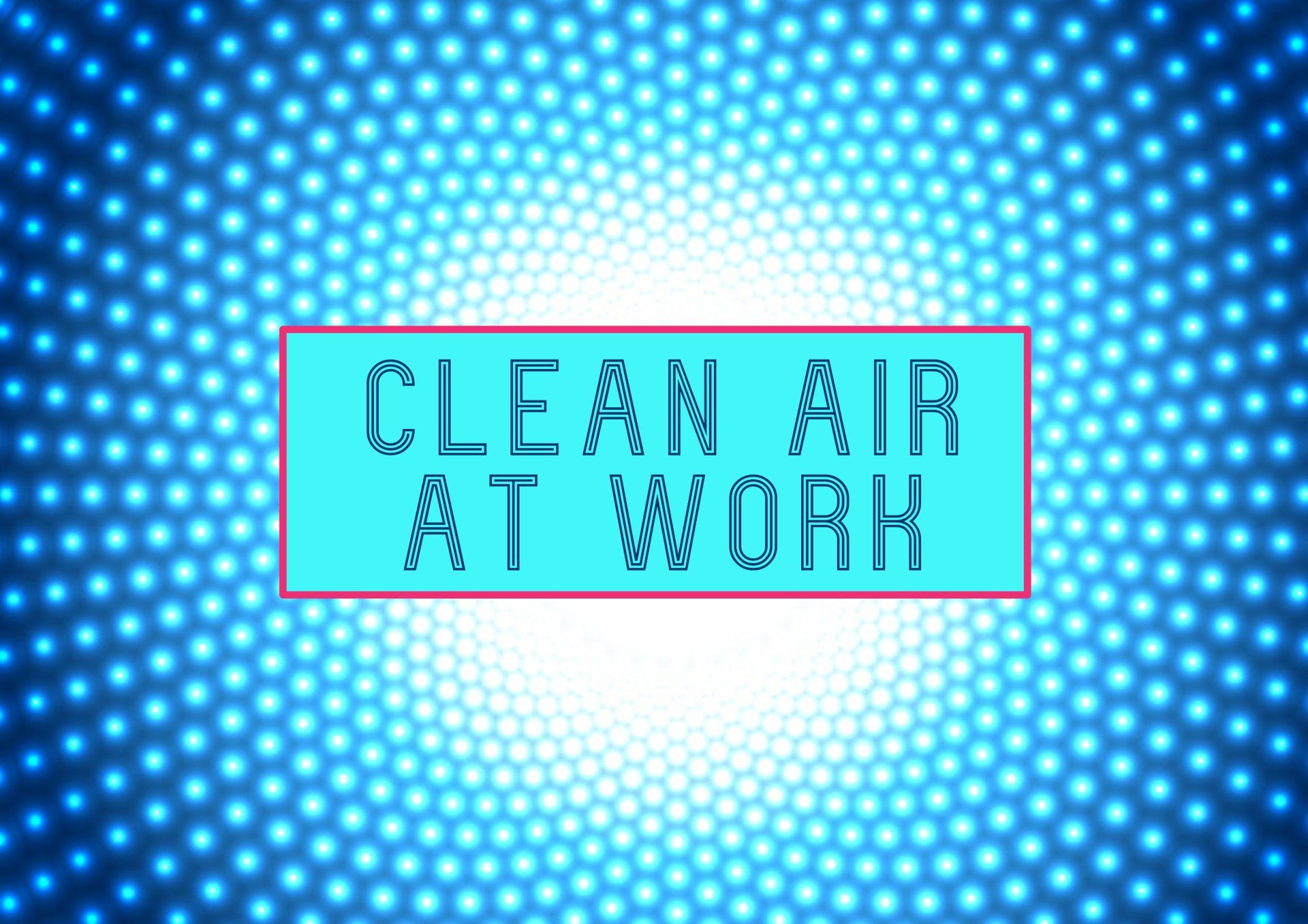
‘Clean Air Day’, is on 20th June each year. An event co-ordinated by environmental change charity, Global Action Plan, and will see local schools, workplaces, hospitals and communities across UK cities run events and inspire other residents to act for their own health and the health of local children. Looking at this from a workplace perspective, what effect does poor air quality have on us as employers and employees? The truth is, half of us probably don’t even realise that we are breathing in polluted air in the workplace, unless there is an obvious issue such as damp or mould. We associate polluted air with outside, an obvious example is traffic fumes. However, we spend nearly 90% of our time indoors and much of that is in the workplace, often with closed windows and no source of fresh air. There are many contributory factors that can cause poor air quality within the workplace, temperature, chemicals, bacteria, pollen, dust, emissions from office equipment, and unpleasant odours. This coupled with an inadequate ventilation system leads to contaminated air trapped in the space around us and an increase in CO2 levels. So how does poor 'Air Quality' affect us? There has been lots of new documented research that has shown poor air quality to have negative effects on thinking, health and productivity. In terms of health, there is a recognised term for it, ‘Sick Building Syndrome’ (SBS), where people in a building suffer from symptoms of illness or feel unwell for no apparent reason. Symptoms include headache, eye, nose, and throat irritation, fatigue, dizziness and nausea. The severity of symptoms is linked to the time people spend in the building and indeed they improve or disappear altogether, the longer people are away from the building. Poor Air quality has also been proven to significantly lower our productivity levels and impair our cognitive thinking. You know that sluggish feeling you get, when you could quite literally fall asleep at your computer screen? If it happens in the morning, we blame a poor night’s sleep and if it occurs in the afternoon, we normally associate it with eating lunch. However, a recent study conducted by the Harvard Centre for Health and the Global Environment, made headlines when researchers found that higher levels of CO2 and VOCs in the air led to lower cognitive scores. (VOCs are group of carbon-based chemicals which evaporate easily at room temperature. They can be found in paints, solvents, upholstery fabrics, carpets and adhesives, varnishes, vinyl floors, cleaning chemicals, air fresheners, cosmetics, fuel oil, and moth balls. They can be produced by dry cleaning, cooking, smoking, using some non-electric space heaters, photocopying or printing). The Harvard study involved testing a group of employees on a period of 6 working days. On different days, they were exposed to varying levels of ventilation, chemicals and carbon dioxide, then tested on their ability to carry out everyday office tasks such as, make decisions, complete goals and strategise etc. (conventional, green and “green+” offices.) The results found that on ‘green days’ (where ventilation was improved & fresh air was pumped into the office) cognitive scores improved by 61% on scores from conventional days. These scores increased further to more than 100% on ‘green + days’ (ventilation was improved further by doubling the amount of fresh outside air circulated). Significantly, Cognitive scores decreased when CO2 levels returned to levels normally found in an office environment.

The term ‘Biophilia’ when translated from its Latin roots means ‘Bio’ = Life and ‘Philia’ = 'the love of' so in a nutshell, the “love of life or living systems”. Erich Fromm, German-born American psychoanalyst, first coined the phrase to describe a psychological orientation of being attracted to all that is alive and vital. It became more well-known following the publication of Edward O Wilson's (an American Biologist) book in 1984, entitled ‘Biophilia’. He defined ‘Biophilia' as “the urge to affiliate with other forms of life” and suggests that humans’ innate tendency to seek connections with nature is rooted in our biology and has built up through thousand of years living in agrarian settings.

Hands up! If it is extremely likely that you will eat lunch at your desk today! In fact, how likely is it that you will skip lunch all together? We are all guilty. We all know it is not good for us to stay sitting down all day. Indeed there are numerous reports, television programmes and media campaigns telling us so. Yet, in today's pressured work environment, when there are not enough hours in the day and a deadline looms, it is easy to feel that we can’t afford to move away from our desks. In fact, it is estimated that between 40-60 per cent of us typically eat lunch at our desk during the working day. Not only does remaining at our desks all day, decrease our productivity and increase stress levels, it can cause a whole host of health issues including back pain, leg disorders, and increased risk of heart disease. This week is BNF Healthy Eating Week, a dedicated week in the year to encourage organisations across the UK (including workplaces, universities, and schools) to focus on healthy eating and drinking, and physical activity, and celebrate healthy living. As most of us already know the negatives of remaining at our desks, let’s look at the benefits of stepping away from our desks and how workplace design can enable ourselves and our employees the opportunity to do this. The Workplace Environment The workplace environment influences the health of its employees and investing in a ‘Healthy Workplace’ makes perfect business sense, however it is important to look at the larger picture to see how the work sp ace itself influences the eating patterns of the employees. For example, if a healthy eating program is offered, remember to look at where employees eat their lunch. A safe and clean eating area is a requirement under most occupational health and safety laws, however we have a great the opportunity make these areas so much more. If designed correctly, they can have a positive influence on encouraging time away from desks, as well as increasing productivity and reducing employee absenteeism. Many forward thinking organisations create a break-taking culture – There’s no doubt that taking a break is good for you, but employees won’t do it if they feel pressurised by their peers to eat lunch at their desk. Progressive managers lead-by-example and encourage their teams to take breaks. This results in happier, more productive employees.
